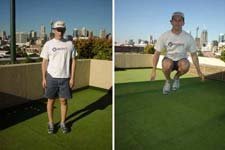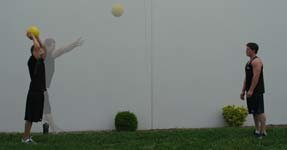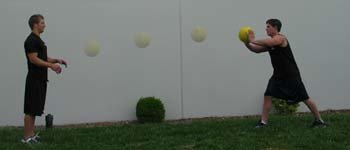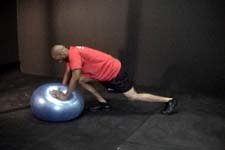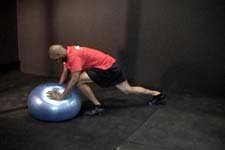
TOPIC: What Is The Best Track Workout?

The Question:
Track athletes have a different type of workout because they rely on speed, strength and power. Of course the workouts will vary with each type of competition but overall what kind of workout can be expected? How much time will they actually spend in the gym vs. the track?
What is the best track workout? Why?
How long should the workouts be?
How many workouts per week should be done for maximum benefit?
Show off your knowledge to the world!
The Winners:
- ravadongon View Profile
- Tarkana View Profile
Prizes:
- 1st place - 50 in store credit.

1st Place - ravadongon

The truth is there is no single best workout for track athletes in general. If all athletes wish to become the best they can possibly be they must train specifically according to their events requirements. For example the training of a 100-m sprinter will vary vastly from a long distance runner who competes in the 5,000 m or 1,0000 m. The needs of each athlete are so different.
Short distance runners draw on anaerobic capacity, while long distance runners draw on their aerobic capacity. Below I separate my track workouts into 3 categories: short distance, middle distance and long distance, so workouts can be tailored more to the athletes' needs rather than making gross generalizations.
Keep in mind the below workouts are designed for a track athletes 'OFF SEASON;' where the athlete's aim is to improve his/her times, which will differ from the in season; where the athlete is competing and his goal is to maintain his/her time.
During this period the athlete will be required to decrease volume and intensity of his/her workout regimen, known as 'tapering' by coaches, so the athlete is fresh to perform at their best, and does not overtrain with the increased workload of the in-season.
The following routines are designed for well-conditioned athletes only.
Please seek medical advice before undergoing the workouts below.

Short Distance
100m, 200m, 400m
- Monday: (AM): Plyos + Sprints (PM): Weights (Upper)
- Tuesday: (AM): GPP (medicine ball throwing) + Tempo Runs
- Wednesday: (AM): Plyos + Sprints (PM): Weights (Lower)
- Thursday: (AM): GPP (sled dragging) + Tempo Runs
- Friday: Weights (Upper) + Plyos + Sprints
- Saturday: Flexibility work
- Sunday: Rest (Active Recovery)

 Monday:
Monday:
Weights: Upper Heavy Day
- Upper Max Effort Lift - Work up to 1-5RM
- Supplemental Lift - 3 x 6-10
- Upper Back Lift (Horizontal) - 3 x 6-10
- Elbow Flexion + Elbow Extension (superset) - 6 (total) x 8-12
- Weighted Abdominal work - 3 x 8-15
 Click Here For A Printable Log Of Monday Weights.
Click Here For A Printable Log Of Monday Weights.
Warm-up:
- Jogging until a light sweat is broken.
- Dynamic Stretching and Short Calisthenics.
- Technique Drills (Marching A's, A-Skips, Running A's, B-Skips, Running B's).
- Progressions (usually about 6, with the first one being a fast jog basically and the last being 95% or so).
Plyometrics: (All 3 x 10, 2-3 minutes rest)
Week 1-2:
- Squat Jump
- Split Squat Jump
- Medicine Ball Sit Up
- Push Up
 Click Here For A Printable Log Of Plyometrics Week 1-2.
Click Here For A Printable Log Of Plyometrics Week 1-2.
Week 3-4:
- Cycled Split Squat Jump
- Standing Long Jump
- Double Leg Zig Zag Hops
- Russian Twist
 Click Here For A Printable Log Of Plyometrics Week 3-4.Week 5-6:
Click Here For A Printable Log Of Plyometrics Week 3-4.Week 5-6:
- Double Leg Tuck Jump
- Alternate Leg Bound (long response)
- Combination Bound (short response)
- Ball Push Ups
 Click Here For A Printable Log Of Plyometrics Week 5-6.
Click Here For A Printable Log Of Plyometrics Week 5-6.
Week 7-8:
- Standing Triple Jump
- Double Leg Speed Hop (short response)
- Single Leg Hop (Long Response)
- Overhead Throw
 Click Here For A Printable Log Of Plyometrics Week 7-8.
Click Here For A Printable Log Of Plyometrics Week 7-8.
Week 9-10:
- In Depth Jumps
- Single Leg Speed Hop (Short Response)
- Double Leg Vertical Power Jump
- Drop and Catch Push Ups
 Click Here For A Printable Log Of Plyometrics Week 9-10.Week 11-12:
Click Here For A Printable Log Of Plyometrics Week 9-10.Week 11-12:
- Single Leg Tuck Jump
- Double Leg Speed Hop (Long Response)
- Box Jumps
- Russian Twist
 Click Here For A Printable Log Of Plyometrics Week 11-12.
Click Here For A Printable Log Of Plyometrics Week 11-12.
Sprints:
* Note: For sprinting work please ensure minimum 1 minute worth of recovery for every 10m run.
100m
- 50m x 3
- 60m x 2
- 70m x 2
- 80m x 2
- 90m x 2
- 100m x 2
 Click Here For A Printable Log Of 100m Sprint Routine.
Click Here For A Printable Log Of 100m Sprint Routine.
200m
- 60m x 3
- 80m x 2
- 100m x 2
- 120m x 2
- 160m x 2
- 200m x 2
 Click Here For A Printable Log Of 200m Sprint Routine.
Click Here For A Printable Log Of 200m Sprint Routine.
- 50m x 3
- 100m x 2
- 150m x 2
- 200m x 2
- 300m x 2
- 400m x 2
 Click Here For A Printable Log Of 400m Sprint Routine.
Click Here For A Printable Log Of 400m Sprint Routine.

 Tuesday:
Tuesday:
GPP (Medicine Ball Throwing):
Perform for 10-15 minutes in circuit fashion.
- Medicine Ball Chest Pushes x 10
- Medicine Ball Double Leg Kicks x 10
- Medicine Ball Backward Overhead Throws x 10
- Medicine Ball Forward Overhead Throws x 10
 Click Here For A Printable Log Of Tuesday: Medicine Ball Throwing.
Click Here For A Printable Log Of Tuesday: Medicine Ball Throwing.
Tempo Runs:
100m
- 2 x 10 x 100m @ 75% max HR with a 30-second recovery between reps and 2 minutes between sets.
200m
- 2 x 8 x 200m @ 72% max HR with 1 minute recovery between reps and 2 minutes between sets.
400m
- 8 x 400m @ 75% max HR with 2 minutes recovery between reps. If it is not possible to maintain tempo, then a recovery of 3-4 minutes, can be taken half way through.

 Wednesday:
Wednesday:
Weights: Lower Heavy Day.
- Lower Max Effort Lift - work up to 1-5RM
- Unilateral lift - 3 x 6-12
- Posterior Chain - 3 x 6-12
- Weighted Oblique work - 3 x 10-20
 Click Here For A Printable Log Of Wednesday Weights.
Click Here For A Printable Log Of Wednesday Weights.
Plyos + Sprints:
- Same as Monday.
[ See Above ]

 Thursday:
Thursday:
GPP: (Sled Dragging): Power Striding NOT Running/Sprinting.
- 90-120 lbs x 5 minutes (increasing in 1 minute increments each session)
Once you can go for 15 minutes with that weight increase it by 10-20 lbs
Tempo Runs:
- Same as Tuesday.
[ See Above ]

 Friday:
Friday:
Weights: Upper Repetition + Lower Body Speed Day.
- Olympic Lifting (Power clean or Power snatch) - 8 x 3 @ 70% 1RM
OR
- Speed Box Squats - 8 x 2 @ 45-60% 1RM
- Repetition Effort Lift - 3 x MAX REPS
- Upper Back Lift (Vertical) - 3 x 8-12
- Medial Delt Lift - 3 x 8-12
- Elbow Flexion + Elbow Extension (superset) - 6 (total) x 8-12
- Abdominal Circuit Training - pick 4-6 non weighted abdominal and oblique exercises and perform them in circuit fashion

 Click Here For A Printable Log Of Friday Weights 2.
Click Here For A Printable Log Of Friday Weights 2.
Plyos + Sprints:
- Same as Monday.
[ See Above ]

 Saturday:
Saturday:
Static Stretching: 15-20 Seconds Per Limb.
- Chest Stretch
- Upper Back Stretch
- Shoulder Stretch
- Side Bends
- Abdominal + Lower Back Stretch
- Quadriceps Stretch
- Hamstring Stretch
- Gastrocnemius Stretch
- Soleus Stretch
 Click Here For A Printable Log Of Saturday Stretching.
Click Here For A Printable Log Of Saturday Stretching.

 Sunday:
Sunday:
No running on this day, however going for a light walk is optional. Static or PNF Stretching is recommended as are other recovery techniques such as Epsom salt baths, alternating showers, full body massages. These are just a few of your options for recovery.

Middle Distance:
800m, 1500m, 3000m.
- Monday: Weights (Upper) + Speed Development.
- Tuesday: GPP (bodyweight circuit) + Tempo Runs.
- Wednesday: Interval Running.
- Thursday: GPP (sled dragging) + Tempo Runs.
- Friday: Weights (Lower) + Plyos + Speed Development.
- Saturday: Rest/Recovery.
- Sunday: Easy Run.

 Monday:
Monday:
Weights: Upper Day.
- Upper Body Press (Bench Press/Military Press/Dips) - 3 x 5-8
- Upper Back Lift (Rows/Pullups) - 3 x 5-8
- Weighted Abdominal Work - 3 x 10-20
- Weighted Oblique Work - 3 x 10-20
 Click Here For A Printable Log Of Monday Weights.
Click Here For A Printable Log Of Monday Weights.
Speed Development:
- See plyos under short distance section and complete the sprints recommended for a 400m runner.
[ See Above ]

 Tuesday:
Tuesday:
GPP: Bodyweight Circuit.
Perform for 10-15 minutes in circuit fashion
- Burpees x 20
- Pushups x 5
- Bodyweight squats x 20
- Slalom Jumps x 20
- Lunges x 20 each leg
- Jumping Jacks x 20
 Click Here For A Printable Log Of Tuesday: Bodyweight Circuit.
Click Here For A Printable Log Of Tuesday: Bodyweight Circuit.

Burpee.
Tempo Runs:
800m
- 2 x 10 x 100m @ 75% max HR with 30 second recovery (jogging) between reps and 2 minutes between sets.
1500m
- 2 x 8 x 200m @ 72% max HR with 1 minute recovery (jogging) between reps and 2 minutes between sets.
3000m
- 8 x 400m @ 75% max HR with 2 minutes recovery (jogging) between reps. If it is not possible to maintain tempo, then a recovery of 3-4 minutes, can be taken half way through.

 Wednesday:
Wednesday:
Interval Running:
800m: The Kiprotich I.
- Run 8 x 200 meters at your current 800-meter race pace, with just 10 meters of jog recovery between intervals.
1500m: Horwill II.
- 2 x (3 x 200) at your best-possible 400-meter speed. 400-meter speed is about eight seconds per 400 (and four seconds per 200) faster than 1-mile race speed. Take 2-minute rests between the 200s within the set and a 5-minute recovery between sets.
3000m: The Old Fashioned.
- Just run 8-10 x 400 meters at your goal 1-mile pace, which should be no more than four seconds per 400 faster than your current one-mile race speed. Start with three-minute recoveries, and try to pare down recovery duration over time.

 Thursday:
Thursday:
GPP (Sled Dragging): Power Striding NOT Running/Sprinting.
- 90-120 lbs x 5 minutes (increasing in 1-minute increments each session)
Once you can go for 15 minutes with that weight increase it by 10-20 lbs.
Tempo Runs:
- Same as Tuesday.
[ See Above ]

 Friday:
Friday:
Weights: Lower Day.
 Click Here For A Printable Log Of Friday Weights.
Click Here For A Printable Log Of Friday Weights.
Speed Development:
- See plyos under short distance section and complete the sprints recommended for a 400m runner.
[ See Above ]

 Saturday:
Saturday:
- No running on this day, however going for a light walk is optional. Static or PNF Stretching is recommended as are other recovery techniques such as Epsom salt baths, alternating showers, full body massages and any other recovery techniques.

 Sunday:
Sunday:
- Easy run (75% race pace) for 4 minutes (800m), 6 minutes (1500m), 8 minutes (3000m).

Long Distance:
5000m, 10000m.
- Monday: Weights (Upper) + Tempo Run
- Tuesday: GPP (bodyweight circuit) + Interval Running (The Herb Elliot I)
- Wednesday: Fartlek Running
- Thursday: GPP (sled dragging) + Steady Run
- Friday: Weights (Lower) + Plyos + Speed Development
- Saturday: Tempo Run
- Sunday: Interval Running (The Billat)

 Weight Training Set/Repetition Scheme:
Weight Training Set/Repetition Scheme: (Unless Stated Otherwise).
(Unless Stated Otherwise).
- Week 1-2: 1 x 20 (1 minute rest)
- Week 3-4: 2 x 15 (1.5 minute rest)
- Week 5-6: 3 x 12(2 minute rest)
- Week 6-7: 3 x 10 (2 minute rest)
- Week 7-8: 3 x 8 (2.5 minute rest)
- Week 9-10: 3 x 6 (3 minute rest)
- Week 11-12: 3 x 4 (4 minute rest)

 Monday:
Monday:
Weights: Upper Day.
- Upper Body Press (Bench Press/Military Press/Dips)
- Upper Back Lift (Rows/Pullups)
- Weighted Abdominal Work - 3 x 10 -20
- Weighted Oblique Work - 3 x 10-20
 Week 1-2, Week 3-4, Week 5-6, Week 6-7, Week 7-8, Week 9-10, Week 11-12
Week 1-2, Week 3-4, Week 5-6, Week 6-7, Week 7-8, Week 9-10, Week 11-12
Tempo Run:
5,000m:
- 6 x 2 x 400m @ 65-70% max HR with 30 second recovery (jogging) between reps and 2 minutes between sets.
10,000m:
- 6 x 2 x 800m @ 65-70% max HR with 30 second recovery (slow jogging) between reps and 2 minutes between sets.
GPP (Bodyweight Circuit):
Perform for 15-25 minutes in circuit fashion
- Burpees x 20
- Pushups x 5
- Bodyweight squats x 20
- Crunches x 25
- Lunges x 20 each leg
- Jumping Jacks x 20
- Mountain Climbers x 30 seconds
- Slalom Jumps x 30 seconds
 Click Here For A Printable Log Of Tuesday: Bodyweight Circuit.
Click Here For A Printable Log Of Tuesday: Bodyweight Circuit.
Interval Running: Herb Elliot I.
To carry it out, run 3 x 800 at 5-K pace, with 2-minute recoveries, scoot 2 x 800 at 10-K pace, with 2-minute recoveries, and then ramble 3200 meters at 10-K velocity without stopping.
This session, in which you run about half of a 5K and half of a 10K at the relevant paces, improves your efficiency and confidence at 10-K speed, while also heightening lactate threshold, speed stamina and max aerobic capacity.

 Wednesday:
Wednesday:
Fartlek Running:
5,000m:
- 8-10 intervals of 1:00 faster jog /1:00 easy jog OR 6-8 intervals of 2:00 faster jog/1:00 easy jog.
10,000m:
- 18-20 intervals of 1:00 faster jog/1:00 easy jog OR 12-14 intervals of 2:00 faster jog/1:00 easy jog.

 Thursday:
Thursday:
GPP (Sled Dragging): Power Striding NOT Running/Sprinting.
- 60-80 lbs x 10 minutes (increasing in 1 minute increments each session)
Once you can go for 20 minutes with that weight increase it by 10-20 lbs.
Steady Run:
- Steady run (75% race pace) for 20 minutes (5000m), 40 minutes (10000m)

 Friday:
Friday:
Weights: Lower Day.
- Olympic Lifting (Power clean or Power snatch) - 8 x 3 @ 70% 1RM
- Squat/Deadlift
- Unilateral Lift
- Posterior Chain
- Abdominal Circuit Training - pick 4-6 non weighted abdominal and oblique exercises and perform them in circuit fashion.
 Week 1-2, Week 3-4, Week 5-6, Week 6-7, Week 7-8, Week 9-10, Week 11-12.
Week 1-2, Week 3-4, Week 5-6, Week 6-7, Week 7-8, Week 9-10, Week 11-12.
Speed Development:
- See plyos under short distance section and complete the sprints recommended for a 400m runner.
[ See Above ]

 Saturday:
Saturday:
Tempo Run:
- See Monday.
[ See Above ]

 Sunday:
Sunday:
Interval Running: The Billat.
- "Running 5 x 3 minutes at your velocity at VO2max (i.e., VO2max), with three-minute recoveries."

Length:
How Long Should The Workouts Be?
Workouts will vary in length for different types of athletes. Shorter distance runners in general will complete shorter workouts at a higher intensity, then longer distance runners who will in general complete longer workouts at lower intensities.
No set time can be given for workouts, unless workouts have been allocated specific times to be completed within (as stated in the plans).

Amount:
How Many Workouts Per Week Should Be Done For Maximum Benefit?
Generally the athlete should train 5-7 days per week in the off season. If an athlete is training everyday, some light/low volume and intensity days should be included for recovery purposes (i.e. so the athlete does not overtrain).
In the athletes' in-season, workload should be decreased as the athlete needs to be fresh to perform at his best, so tapering of the program must occur.

Links
- Track Workouts For Middle Distance To Long Distance Runners
- Long Distance Running Technique [ online ]
- Middle Distance Running Technique [ online ]
- Short Distance Running Technique [ online ]

Rep Max Calculators
| REP MAX CALCULATOR |
Enter the amount of weight you can lift (in pounds) and the number of reps you can lift it for.
|
| 1-5 RM CALCULATOR |
Enter the amount of weight you can lift (in pounds) and the number of reps you can lift it for.
|

Heart Rate Calculator
| MAX HEART RATE CALCULATOR |
Enter your age, then press "Calculate".
|

2nd Place - Tarkana
The Track Routine 
The type of training track runners must go through is different than what a weightlifter would. While typical weight lifting simply focuses of being able to lift as much as possible, runners' goals are different. What matters for them is being able to move as fast as possible and maintain their speed the best they can.
To accomplish this, runners need a different type of muscular capacity: one of quick, powerful movements and of much greater endurance. Even more variation comes into play when one considers the different events a runner may compete in; a 100m sprinter [or hurdler] has much different needs than a 5k runner.

Basics Of A Track Workout
When the objective is to improve running performance, obviously the majority of your training should be running. Just as with any other sport, the training for the sport takes much higher priority than hitting the weights (though it's still optimal to do so, and sports like football will focus on that anyway). A significant difference is that while many sports contain condition in practice, here conditioning is the sport.
The first thing any runner needs to do is to keep loose. Pulling muscles is most common among runners (as well as shin splints and Osgood-Schlatters - it isn't as easy as it seems), so it is important to stretch out the groin, quads, hamstrings, calves and lower back well before and after exercise and also any day you don't train.
 |
Osgood-Schlatters: Refers to partial avulsion of the tibia tuberosity, with no involvement of the tibial physis. Usually occurs in patients in late childhood or early adolescence. More common in boys, it may represent an overuse disease. The repetitive stress on tuberosity may cause partial avulsion. If intervening gap fills with fibrous tissue rather than bone, a painful non union will develop. Secondary defective ossification will cause prominence of the tubercle too. |
 |
 |
||
The other thing they should be doing is plyometric drilling and focusing on running form (which also differs slightly between sprinters and long-distance runners) to keep the running as efficient a possible.
A big difference between track training and bodybuilding is that the training can remain much more steady, using a much more constant training routine. There will be some differences in the running workout for training the different energy systems in slightly different ways, but for the most part, you wouldn't need to hit your heart muscle from every angle or shock your lungs into growth.
If one simply ran a mile every other day, and honestly tried their hardest, they could continue to improve on that (yes, eventually more distance would be much more effective, but the point stands).

Runner In The Gym
As I said before, weightlifting will be far from the main focus of your track training, but many benefits can be obtained from lifting, and after all, that is the point of this article. For runners, weightlifting should be frequent enough to establish a quick recovery, but it shouldn't interfere with track practice.
For this reason, I recommend a 3-day full-body workout (yeah, I push the high frequency a lot, but here it makes even more sense). The workout will focus on power and endurance. Like it's been mentioned, sprinters and long-distance runners have much different needs, so there are two different workouts for each.
It is important to note that though runners tend to focus primarily on the quads, as the quads develop, so must the hamstrings or they run a much greater risk of being pulled. On top of that, having good posterior chain and core strength is beneficial anyway.

 Sprinter's Lifting Routine:
Sprinter's Lifting Routine:
Day 1 - Power:
These should be done with a weight around 60-65% of your max and performed with the concentric as fast as possible and a 1-2 minute rest between sets. With the exception of the abdominal exercises, perform the workout as 5 circuits.
- 5 x 10 Squats
- 5 x 10 SLDL
- 5 x 15 Calf Raises
- 5 x 10 Push Press
- 2 x 12 Weighted Sit-ups
- 2 x 10 Weighted Twisting Sit-ups
- 2 x 8 Leg Raises
 Click Here For A Printable Log Of Day 1: Power.
Click Here For A Printable Log Of Day 1: Power.
Day 2 - Speed-Endurance:
Yes, sprinters need endurance too. Besides, this is still more to increase quick power, just with a little more lactic acid resistance being built in. The weight here should be closer to 50% of your max and performed as quickly as possible with 30-45 seconds rests between sets.
- 3 x 25 Deadlifts
- 3 x 25 Hyperextensions
- 3 x 25 Leg Curls
- 3 x 25 Calf Raises
- 3 x 25 Cleans
- 2 x 12 Weighted Sit-ups
- 2 x 10 Weighted Twisting Sit-ups
- 2 x 8 Leg Raises
 Click Here For A Printable Log Of Day 2: Speed-Endurance.
Click Here For A Printable Log Of Day 2: Speed-Endurance.
Day 3 - Strength:
Unlike long-distance runners, lower body strength is essential to sprinters to produce the force needed to speed up so quickly. Here lifts are controlled and there is a 2-minute rest between sets.
- 5 x 5 Squats
- 5 x 5 Romanian Deadlifts
- 5 x 7 Calf Raises
- 5 x 5 Bent-over Rows
- 2 x 12 Weighted Sit-ups
- 2 x 10 Weighted Twisting Sit-ups
- 2 x 8 Leg Raises
 Click Here For A Printable Log Of Day 3: Strength.
Click Here For A Printable Log Of Day 3: Strength.
If you somehow get to the point where your lifts (mainly squat) near double your bodyweight without gaining excessive muscle bulk, stop increasing the weight and instead add sets, decreased rest time or more reps (unless you have other reasons to continue increasing the weight).

 Long-Distance Runner's Lifting Routine:
Long-Distance Runner's Lifting Routine:
These will be less specialized than a sprinter's workout and are mostly speed-endurance. Days 1 and 3 are done as a circuit (minus abdominal work) with a 2-minute rest between circuits. All lifts should be done in a quick, controlled manner.
Day 1:
- 3 x 30 Squat
- 3 x 30 SLDL
- 3 x 30 Calf Raises
- 3 x 30 Push Press
- 2 x 12 Weighted Sit-ups
- 2 x 10 Weighted Twisting Sit-ups
- 2 x 8 Leg Raises
 Click Here For A Printable Log Of Day 1.
Click Here For A Printable Log Of Day 1.
Day 2:
Have about a 30-second rest between sets and with a weight that provides good resistance, but is still manageable to do with speed.
- 5 x 10 Squat
- 5 x 10 Calf Raises
- 5 x 10 Cleans
- 5 x 10 Deadlifts
- 2 x 12 Weighted Sit-ups
- 2 x 10 Weighted Twisting Sit-ups
- 2 x 8 Leg Raises
 Click Here For A Printable Log Of Day 2.
Click Here For A Printable Log Of Day 2.
Day 3:
- 4 x 15 Lunges
- 4 x 15 Good-Mornings
- 4 x 15 Calf Raises
- 2 x 12 Weighted Sit-ups
- 2 x 10 Weighted Twisting Sit-ups
- 2 x 8 Leg Raises
 Click Here For A Printable Log Of Day 3.
Click Here For A Printable Log Of Day 3.
If your squat reaches the point where you lift 1.5 times your bodyweight, stop increasing the weight and instead increase reps, sets or decrease between-set rests.
This lifting routine should give you good results improve your running ability. If you become too sore or fatigued to practice running effectively, reduce the volume or weight.

On-Track Training
Most likely, you'll have track practice daily and your coach will have a routine set up for you. But in case you lack a coach's help or don't like their methods in the off season, here's an example of a 4-day routine. Make sure to warm-up, properly stretch and cool down with each running session.

 Long Distance Running:
Long Distance Running:
Day 1:
- 4 x 400m run (30 second rest)
- 2 x 800m run (1 minute rest)
- 4 x 400m (30 second rest)
Day 2:
- 8 x 400m near-sprint, 400 jog
Day 3:
- 4 x 1 mile run (5 minute rest)
Day 4:
- 5 mile jog

 Sprint Running:
Sprint Running:
Day 1
- 8 x 200m sprint, 200m jog
 Click Here For A Printable Log Of Day 1: Sprinting.
Click Here For A Printable Log Of Day 1: Sprinting.
Day 2
- 6 x 400m sprint (45 second rest)
Day 3
- 5 x 800m run (2 minute rest)
Day 4
- 10 x 100m sprint, 100m jog, 100m sprint, 100m jog (1 minute rest)
 Click Here For A Printable Log Of Day 4: Sprinting.
Click Here For A Printable Log Of Day 4: Sprinting.
This is a decent template for a running routine, should you be without one. You'll probably need to adjust it to suit your personal needs and increase it as you progress, but this will give you a good outline.

Why This Workout?
This workout routine is specifically designed to target the needs of a runner. Focusing on speed, power and endurance, a runner can greatly improve his/her running time on top of what is gained from regular running practice. The lifting workouts should stay under an hour. They are mostly supplementary to your running practice and shouldn't use up the bulk of your energy.
Track running can last longer. It is the focus of your training. The example provided is more basic level, and with progression, running workouts will be longer, also including more required rest periods.
Keep training hard, run through the exhaustion and you will be able to reach the success you want.





